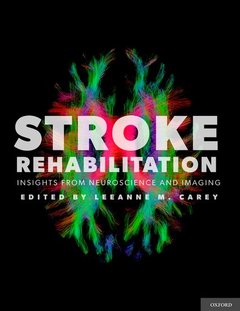Stroke Rehabilitation Insights from Neuroscience and Imaging
Langue : Anglais
Coordonnateur : Carey Leeanne M.

Stroke Rehabilitation: Insights from Neuroscience and Imaging informs and challenges neurologists, rehabilitation therapists, imagers, and stroke specialists to adopt more restorative and scientific approaches to stroke rehabilitation based on new evidence from neuroscience and neuroimaging literatures. The fields of cognitive neuroscience and neuroimaging are advancing rapidly and providing new insights into human behavior and learning. Similarly, improved knowledge of how the brain processes information after injury and recovers over time is providing new perspectives on what can be achieved through rehabilitation. Stroke Rehabilitation explores the potential to shape and maximize neural plastic changes in the brain after stroke from a multimodal perspective. Active skill based learning is identified as a central element of a restorative approach to rehabilitation. The evidence behind core learning principles as well as specific learning strategies that have been applied to retrain lost functions of movement, sensation, cognition and language are also discussed. Current interventions are evaluated relative to this knowledge base and examples are given of how active learning principles have been successfully applied in specific interventions. The benefits and evidence behind enriched environments is reviewed with examples of potential application in stroke rehabilitation. The capacity of adjunctive therapies, such as transcranial magnetic stimulation, to modulate receptivity of the damaged brain to benefit from behavioral interventions is also discussed in the context of this multimodal approach. Focusing on new insights from neuroscience and imaging, the book explores the potential to tailor interventions to the individual based on viable brain networks.
Part A: Core Concepts. 1: Introduction. (Leeanne M. Carey). 1.1 Stroke Rehabilitation: An ongoing window of opportunity. 1.2 The scope of the problem: Prevalence and impact of stroke and increasing need for Stroke Rehabilitation. 1.3 Recovery and Rehabilitation: Definitions. 1.4 Neural plasticity and learning as a basis for stroke rehabilitation. 1.5 Neuroimaging and how it may inform stroke rehabilitation. 1.6 Paradigm shift in stroke rehabilitation. 2: Stroke Rehabilitation: A Learning Perspective. (Leeanne M. Carey, Helene J. Polatajko, Lisa Tabor Connor and Carolyn M. Baum). 2.1 Stroke Rehabilitation: facilitation of adaptive learning. 2.2 A common language for rehabilitation science. 2.3 Experience and learning-dependent plasticity: Implications for rehabilitation. 2.4 Role of brain networks in information processing and recovery. 2.5 Skill acquisition - a learning perspective. 2.5.1 Explicit, task-specific and goal-driven. 2.5.2 Involve active-problem solving and be responsive to environmental demands. 2.6 Application in context of recovery after stroke. 2.7 Rehabilitation Learning Model: Rehab-Learn. 2.8 Selected learning-based approaches to rehabilitation. 2.8.1 Cognitive Orientation to daily Occupational Performance (CO-OP). 2.8.2 SENSe: A perceptual learning approach to rehabilitation of body sensations after stroke. 2.8.3 Language: Constraint-Induced Aphasia Therapy. 2.9 Measuring response to learning-based rehabilitation. 2.10 Summary and Conclusion. 3: Neural Plasticity as a basis for Stroke Rehabilitation. (Michael Nilsson, Milos Pekny and Marcela Pekna). 3.1 Neural plasticity after brain and spinal cord injury. 3.1.1 Experience-dependent plasticity of the cerebral cortex. 3.1.2 Spontaneous recovery of function after stroke. 3.1.3 Cortical map rearrangements. 3.1.4 Contralateral hemisphere involvement. 3.1.5 Contralesional axonal remodelling of the corticospinal system. 3.2 Implications for stroke rehabilitation. 3.3 Increasing neural plasticity through behavioural manipulations and adjuvant therapies. 3.3.1 Enriched environment and multimodal stimulation. 3.3.2 Non-invasive brain stimulation. 3.3.3 Pharmacological modulators of neural plasticity. 3.3.4 Emerging targets. 3.4 Individualized therapy. 4: Imaging techniques provide new insights. (J-Donald Tournier, Richard Masterton and Rudiger J. Seitz). 4.1 Introduction to neuroimaging techniques and their potential to provide new insight. 4.2 What neuroimaging can tell us. 4.2.1 Measuring brain perfusion. 4.2.2 Measuring water diffusion (Diffusion weighted imaging). 4.2.3 Measuring regional cerebral metabolism. 4.2.4 Assessing structural brain lesions. 4.3 Measuring brain function with MRI. 4.3.1 The BOLD image contrast. 4.3.2 The BOLD response to neuronal activity. 4.3.2.1 The time-course of evoked BOLD signal changes. 4.3.2.2 Neurovascular coupling. 4.3.3 fMRI experimental design and analysis. 4.3.3.1 Task-related activation studies. 4.3.3.2 "Resting-state" studies of brain function. 4.3.4 Applications of fMRI in stroke rehabilitation. 4.4 Structural connectivity, including tractography. 4.4.1 Modelling diffusion in white matter. 4.4.1.1 Diffusion tensor imaging. 4.4.1.2 Higher-order models. 4.4.2 Estimating biologically relev
Leeanne M. Carey, PhD, Head, Neurorehabilitation and Recovery, Stroke Division, Florey Neuroscience Institutes, Melbourne Brain Centre, and Professor, Department of Occupational Therapy, School of Allied Health, Faculty of Health Sciences, La Trobe University, Victoria, AUSTRALIA.
Date de parution : 06-2012
Ouvrage de 280 p.
22.3x28.6 cm
Disponible chez l'éditeur (délai d'approvisionnement : 21 jours).
Prix indicatif 235,08 €
Ajouter au panierThèmes de Stroke Rehabilitation :
© 2024 LAVOISIER S.A.S.



